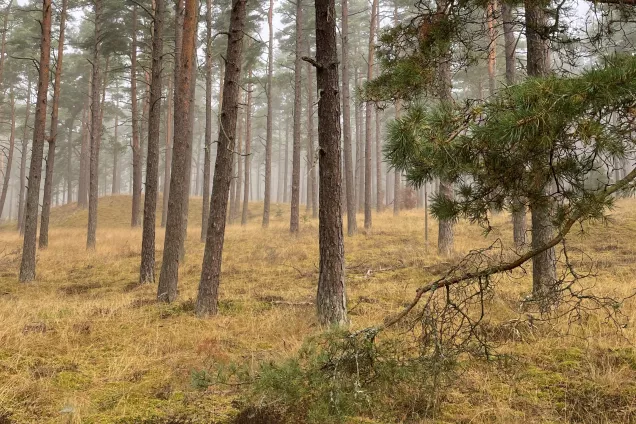Vegetation, emissions and particles (RA3)
The overall aim of RA3 is to formulate and validate a model framework - linking vegetation, aerosols, clouds and their climate feedbacks. To do this, we use a combination of laboratory studies, field studies and modelling.
Aerosol particles and their role for clouds and climate is an important part of climate research and of huge importance for air quality around the world. The concept of short-lived climate pollutants, including particles, are on the political agenda as illustrated by for example the formation of the he Climate and Clean Air Coalition. The terrestrial carbon cycle and aerosol–cloud–climate interactions are key components in the climate system, but they are complex to describe in climate models. The complexity is further compounded by the fact that the biosphere, clouds and particles are related through important feedback processes.
RA3 focuses in particular on:
- the representation of the C and N cycles,
- emissions of biogenic volatile organic compounds (BVOCs) and N-based trace gases from ecosystems,
- the subsequent atmospheric oxidation of BVOCs and their secondary organic aerosol (SOA) formation potential, with consequences for clouds, global radiation and precipitation.
This RA utilizes laboratory set-up, fled observation station and various models as described below.
Model development
The main goal of RA3 is to utilize laboratory and field observations in order to strengthen and develop models. Detailed chemical and aerosol processes are tested in process models where explicit formulations can be used. Examples of such models are box models based on MCM (Master Chemical Mechanism) or similar chemical schemes linked to some dynamic aerosol particle representations often based on information from laboratory work. These schemes can either be used explicitly or reduced for field-model comparison. Currently, three models are developed within MERGE:
- The ADCHEM model is tested in the Lagrangian model
- The Ecosystem surface exchange (ESX) 1-D model is developed for canopy modeling alongside the,
- 3-D EMEP model; this EMEP model will be used to test improved biosphere components and their impact on air quality and aerosols over Europe
RA3 is also, together with RA1, taking part in the development of particle representation in the EC-Earth model.
Laboratory work
Flow reactors and chambers are used to test reaction mechanisms and aerosol processes, while larger oxidation chambers and the access to European infrastructures within strategic research collaboration, e.g. the Plan chamber in Julich and the SAPHIR chamber, allow to mimick atmospheric conditions. Gases and particle composition and properties can be measured with a unique suite of advanced instrumentation enabling an ensemble of analyses that competes on the highest international level.
Field observations
The group is running the EMEP monitoring station at Vavihill (VHL, 56 01N, 13 09E, 172 m asl.). VHL is a continental background site with no local sources of pollution, situated in the southernmost part of Sweden. It is well suited for studies of the influx of polluted air from continental Europe to the Nordic countries along a south-north transect. VHL is equipped with meteorological instrumentation and can measure gases, aerosol particles, and precipitation chemistry. In addition to the involvement in the monitoring station, RA3 researchers are active in several international measurement campaigns utilizing high competence and advanced instrumentations to study atmosphere-cloud-climate interactions.
MERGE researchers at Lund University are jointly operating the co-located ICOS-ACTRIS monitoring station Hyltemossa in southern Sweden. ICOS and ACTRIS aim at producing long-term high-quality observations of
long-lived greenhouse gases and short-lived climate forcers as well as other relevant atmospheric pollutants.
Hyltemossa is located in a managed spruce forest and is an ICOS combined ecosystem and atmospheric station with a 150 m high tower and excellent laboratory and housing facilities. ACTRIS installed a 30 m tower for the aerosol inlet leading air from above the forest canopy down to the 25 m2 ACTRIS laboratory housing our instrumentation. In this tower, ACTRIS installed an eddy-covariance flux system for particles, ozone and volatile organic compounds to facilitate measurements of vertical exchange of particles and gases between the atmosphere and forest. An additional 25 m2 ACTRIS laboratory is placed in a meadow 600 m north of the Hyltemossa main station, intended for instruments requiring shorter inlets and free horizon.
TNA (Transnational Access) is offered to non-Swedish researchers or commercial partners, providing support for the use of the Hyltemossa station.
All ACTRIS and ICOS data from the site are openly available free of charge according to FAIR principles via the ACTRIS Data Portal and the ICOS Carbon Portal, hosted by Lund University. MERGE scientists use data from Hyltemossa to develop models at a wide range of temporal and spatial scales, from detailed aerosol dynamics and atmospheric chemistry process models to global climate and Earth system models.
Links:
Hyltemossa: https://www.icos-sweden.se/hyltemossa
For location: search “Hyltemossa Research Station“ in Google Maps.
ICOS (Integrated Carbon Observation System); www.icos-ri.eu
ICOS Sweden; www.icos-sweden.se
ACTRIS (Aerosols, Clouds, and Trace gases Research Infrastructure); www.actris.eu

Contact RA3 leader
Mattias Hallquist
Department of Chemistry & Molecular Biology, University of Gothenburg
hallq [at] chem [dot] gu [dot] se (hallq[at]chem[dot]gu[dot]se)
Moa Sporre
Department of Physics, Lund University
moa [dot] sporre [at] nuclear [dot] lu [dot] se (moa[dot]sporre[at]nuclear[dot]lu[dot]se)

